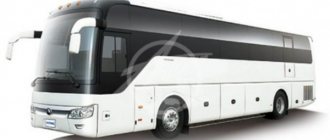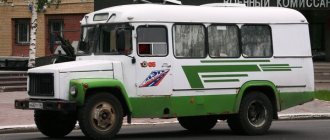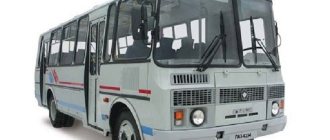fotobus.msk.ru
Domestic public transport is very outdated. According to statistics, more than 70% of buses, trams and trolleybuses are in operation beyond their normal service life. A comprehensive program aimed at modernizing passenger transport will begin in January 2022. More than 35 billion rubles will be allocated for its implementation. Now we’ll tell you what modern buses are already running in some regions of the country.
History in dates
- 1929 — The Yaroslavl Automobile Plant masters the production of Ya-6 bus chassis.
- 1933 - The Stalin Plant masters the production of chassis for AMO-4 buses, the Gorky Automobile Plant - GAZ-03-30 buses.
- 1934 - start of production of ZIS-8 buses.
- 1938 - start of production of ZIS-16 buses.
- 1947 - start of production of ZIS-154 buses.
- 1949 - start of production of ZIS-155 buses.
- 1950 - start of production of GZA-651 buses.
- 1952 - the Pavlovsk Bus Plant (PAZ) came into operation - the first-born of the plant was the GZA (PAZ)-651 bus, transferred from GZA.
- 1958 - The Kurgan Bus Plant (KAvZ) was put into operation - the first-born of the plant was the PAZ-651 bus, transferred from PAZ.
- 1959 - The Likinsky Bus Plant (LiAZ) came into operation - the first-born of the plant was the LiAZ-158 bus, transferred from ZIL.
- 1967 - start of production of LiAZ-677 buses;
- start of production of PAZ-672 buses.
- start of production of LiAZ-5256 buses;
- start of production of PAZ-3205 buses;
- The Golitsyn Bus Plant (GolAZ) came into operation, which existed until 2014 - the first-born of the plant was the GolAZ AKA-6226 bus.
- TMZ has begun assembling Ikarus-415.33 buses;
- start of production of PAZ-3237 Luzhok buses;
- start of production of LiAZ-5292.00 buses.
- start of production of KAVZ-4238 Aurora buses;
- start of production of KAVZ-4235 Aurora buses;
- start of production of LiAZ-6213.65-77 buses;
- The last LiAZ-5256 and LiAZ-5293 buses rolled off the assembly line of the LiAZ plant.
Pavlovsk Bus Plant (PAZ) – modern history with established traditions
After the merger of the main domestic manufacturers of passenger transport by the GAZ Group, the Buses division appeared, which made it possible to breathe new life into Soviet technology. Which, by the way, benefited from such a transformation. Today the company has a certificate ISO 9001 “Quality Management Systems. Requirements" in relation to production and development, as well as warranty and service.
Today this is an enterprise that uses all its designed capacities and is among the TOP 10 major global manufacturers, producing 42 new PAZ buses per day. With the application of the principles of GAZ production systems, starting from 2003, efficiency in reducing costs and reducing costs has increased, and technological processes have been optimized.
The main line of the car plant consists of medium and small classes. Sales of PAZ buses in Russia have reached a new large-scale level and amount to more than 9 thousand units per year. All modernizations, improvements and expansions of modifications are based on the opinions of regular transport customers.
Classification
Digital classification of models
Until 1945, automobile factories in the USSR did not have a common model numbering system. In 1945, the first designation system was adopted, in which each plant was given a range of three-digit model numbers (except for GAZ, which had a range of 1-99). Bus manufacturers occupied the following ranges:
- 100-199 ZIL - models 118, 119, 127, 154, 155 and 158 were produced; production of model 158 transferred to LiAZ
- 652—674 GAZ, since 1950 PAZ and KAvZ. The following models were produced: 651 at all three factories, PAZ-652 and 672, KAvZ-655, 657, 659 and 685.
- 675-694 LiAZ - produced models 158 (transferred from ZIL), 676 (experimental) and 677.
- 695-699 LAZ - all numbers in the range were used.
- 975-999 RAF - models 975-980 and 982 were produced, as well as RAF-251 (from the Novosibirsk Automobile Plant range, repurposed in 1949).
Some experimental bus models were not numbered according to the standard, for example: RAF-08 and RAF-10, ZiU-6 and ZiU-8.
In 1966, the industry standard OH 025270-66 was adopted, according to which all new models of cars, buses and trolleybuses began to be numbered. However, some new models were released with numbers according to the old system: the ZIL-119 minibus in 1971, the ZiU-682 and 683 trolleybuses and others. Many models continued to be released and received modifications. Currently, the Dneprodzerzhinsk Bus Plant produces the LAZ-695N bus, numbered according to the old system[2].
See List of models of buses and trolleybuses according to OH 025270-66.
In the 1966 industry standard, model numbers have 4 digits, sometimes adding a fifth - the modification number. Second digit of the number 2
and means that this is a bus or trolleybus (There are exceptions, for example, the experimental KAvZ-3100 and the serial KAvZ-3976). The first digit is the bus capacity class, determined by overall length:
- 2
— especially small, up to 5 meters - 3
- small, from 6 to 7.5 meters - 4
- medium, from 8 to 9.5 meters - 5
- large, from 10.5 to 11 meters - 6
- especially large, over 11.5 meters
After the collapse of the USSR, bus models in Russia continue to be numbered according to OH 025270-66. In Belarus, MAZ and Belkommunmash abandoned this system. In Ukraine, for some time, new models were also assigned numbers according to the Soviet industry standard, and the numbers were occupied independently of Russia (for example, number 6205 was occupied by the LAZ bus and the ZiU trolleybus). Later, a new system was adopted, according to which models receive an index from the letter ( A
for buses and
T
for trolleybuses) and three numbers. Despite this, the Kherson Automobile Assembly continues to number models according to OH 025270-66.
Russian manufacturing companies (for 2022)
| The section lacks links to sources. Information must be verifiable or it may be deleted. You can edit the article to add links to authoritative sources. This mark was set on March 26, 2022 . |
NefAZ-5299 GolAZ-6228 LiAZ-5292 PAZ-4230 Volzhanin-6270.06 “Cityrhythm 15” VDL-NefAZ-52998
- Volgabus
- Buses LLC GAZ, Nizhny Novgorod
- LLC EvoBus Russland, Moscow
- Kurgan Bus Plant, Kurgan
- LiAZ, Likino-Dulyovo
- Buses OJSC NefAZ, Neftekamsk
- LLC PKF "Luidor", Nizhny Novgorod
- Buses LLC ST Nizhegorodets, Nizhny Novgorod
- Pavlovsky bus, Pavlovo
- LLC Rodnikovsky Machine Plant, Rodniki
- LLC Samotlor-NN, Nizhny Novgorod region
- Buses ZAO NPP SemAR, Semenov
- Buses Scania-Peter LLC, St. Petersburg
- Sollers-Elabuga LLC, Elabuga
- Buses ZAO Tushino-Avto, Moscow
- Ulyanovsk Automobile Plant, Ulyanovsk
- Buses OJSC AZ Ural, Miass
- Buses LLC PKF Luidor, Nizhny Novgorod region
- SIMAZ, Ulyanovsk
Stopped bus production
- AMO ZIL buses, Moscow (2012).
- Buses Olympus, Vologda (2017).
- Golitsyn Bus Plant, Golitsino (2014).
- JSC Michurinsky Bus, Michurinsk (2011).
- LLC Rostov Bus Plant, Rostov-on-Don (2011).
- LLC Taganrog Automobile Plant, Taganrog (2014).
- BAW-RUS Motor Corporation, Ulyanovsk (2016).
Classification by manufacturing companies
According to classes (length) there are
- Russian buses of especially small class (OM) up to 6 m long (GAZ, UAZ)
- Russian small class buses (M) 6.1-8 m long (PAZ, KAVZ, RZGA (Hyundai), ZIL, Rodnik, Vika)
- Russian middle class buses (C) 8.1-10 m long (Likinsky bus - LiAZ-4292, PAZ, KAvZ)
- Russian large class buses (B) 10.1-12 m long (Volgabus, Likinsky bus, NefAZ, Scania-Peter, RAM (Marco Polo))
- Russian buses of especially large class (OB) with a length of 12.1-18 m (Likinsky bus)
- Russian special rotational buses (SV) (Ural, NefAZ)
Buses at the Comtrans exhibition: Valdai, Citymax and others
It is gratifying that at the current Comtrans, much attention is paid to environmentally friendly transport - electric buses and water buses. But, fortunately, traditional buses have not been forgotten. How will passengers be transported in ordinary life in poor Russia?
And again the most interesting thing is at the GAZ stand. The plant has done serious work and shown the first results of its comprehensive program for the passenger transportation market. A whole line of low-floor buses with a length from 6.8 to 18 meters is in development. The first samples are already ready.
The updated Gazelle NN, like Next, will be produced in the form of a frame-panel minibus. It seats 22 people with 14 seats and is called Gazelle City. But its older brother on the Valdai Next chassis has not yet been in the program.
These buses have in common a low floor within the base, a wide doorway (1200 mm) and a spacious storage area. In addition, GAZ residents have finally thought about luggage compartments (the eternal problem of the first minibuses!). The Valdai cabin has 21 seats plus three folding seats on the platform, and the total passenger capacity is 32 people. Under the hood is the same Cummins 2.8 diesel engine, the gearbox is a new gas six-speed. The front suspension of the bus is from Lawn Next, the rear air suspension and braking system are from Vector Next. Valdai City will be produced at the Pavlovsk plant.
Even more interesting is the latest example of the Citymax urban bus series. This is a completely new car with a rear engine and a futuristic look. The first model from a whole line is shown at the exhibition - Citymax 9. The nine-meter bus will also be produced at PAZ, and its older brothers - at LiAZ, while the vehicles are 70% unified. They will have completely new bodies of increased rigidity and increased glass area (with double-glazed windows on request). The doorways are widened (up to 1430 mm), the interior layout changes to suit the requirements of specific customers. The bus for 75 passengers is equipped with a YaMZ-534 diesel engine and an automatic transmission.
The front axle is from the Kanash plant, part of the GAZ Group, the rear axle is from the Chinese HanDe. Of course, a modern car is equipped with electronic security systems, including internal cameras, and instead of rear-view mirrors, cameras and monitors are installed. It’s just a pity that Gazovians have not yet announced the prices of promising buses.
Finally, a few words about the current range. For now, the production of urban LiAZs and Vector Next PAZs will continue. But the situation with classic grooves is unclear: according to rumors, ZMZ is closing the production of ancient V8 engines, and diesel versions have long been discontinued.
However, there are still enough relatively cheap buses on the market. For example, Comtrans had a SimAZ-2258. The almost nine-meter long bus can accommodate 30 passengers. Of course, the Isuzu truck chassis with leaf spring suspension and an inconvenient service hatch in the front is not the latest solution, but a gas version has appeared with an updated front mask at a price of 6.5 million rubles.
Samauto HD50 from Uzbekistan
And Comtrans also hosted the first show of its direct competitor, the Samauto HD50 diesel bus from Uzbekistan. Built on the same chassis, the shorter eight-meter bus carries 44 passengers (at the expense of space for standing passengers). At the same time, the manufacturer has already certified it in Russia and is asking for half a million rubles less.
It’s strange, but for some reason the very popular segment of intercity transportation in the country was ignored at the exhibition. Of all the manufacturers, only KAMAZ showed such a gas bus, and even that was lost among its hydrogen and electric counterparts. It seems that this segment is completely at the mercy of Chinese brands. The production of domestic models is small, and only a few customers, such as sports clubs, can afford “European” models. Therefore, at the exhibition there were only traditional Yutong and KingLong. Their prices are similar, as are the buses themselves: models with 55 seats cost about 11 million rubles.
Statistics
In 2010, 40.9 thousand buses were produced in Russia, in 2011 - 44.2 thousand, in 2012 - 58.6 thousand, in 2013 - 53.2 thousand, in 2014 - 44.0 thousand, in 2015 - 36.4 thousand. In January-November 2016, production increased by 17.4% compared to the same period in 2015, amounting to 38.0 thousand units[3].
| Production in 2007 [4] | |
| All factories | 88824 |
| GAZ Automobile Plant LLC, Nizhny Novgorod | 39625 |
| OJSC "UAZ", Ulyanovsk | 18255 |
| PAZ LLC, Pavlovo-on-Oka | 15031 |
| LLC "KAvZ", Kurgan | 4083 |
| LLC "TagAZ", Taganrog | 3371 |
| LiAZ LLC, Likino-Dulyovo | 2894 |
| Samotlor-NN LLC, Nizhny Novgorod region | 2034 |
| OJSC "NefAZ", Neftekamsk | 1307 |
| LLC PKF "Luidor", Nizhny Novgorod | 1021 |
| OJSC "AZ Ural", Miass | 990 |
| JSC "Golitsyn Bus Plant", Golitsino | 492 |
| ZAO Tushino-Avto, Moscow | 465 |
| CJSC NPP SemAR, Semenov | 395 |
| LLC VAP Volzhanin, Volzhsky | 297 |
| LLC EvoBus Russland, Kolomna | 241 |
| JSC Michurinsky bus, Michurinsk | 162 |
| Scania-Peter LLC, St. Petersburg | 132 |
| AMO ZIL, Moscow | 26 |
| LLC Rodnikovsky Machine Plant, Rodniki | 18 |
| LLC Vika LTD, Kurgan | 2 |
Turn of the 19th-20th centuries
The first domestic trolleybus
In 1899, an inventor from St. Petersburg, Ippolit Romanov, built the first Russian omnibus. It was a very massive structure, weighing 1600 kg, designed to carry 15 people. The car was driven by two electric motors produced by the American Maurice-Salon, powered by batteries. The maximum speed was 10 km/h. The electric omnibus was presented to local officials only in 1901. The residents of St. Petersburg were amazed by the smooth and silent movement of the equipment. But the inventor was unable to find investors. Therefore, the project sank into oblivion.
The creator of the first Russian car, Petr Frese, tried to develop Romanov’s idea. In the design of the electric omnibus, he got rid of batteries and installed a current collector on the cars, which received energy from two electric wires hung on street poles. Thus the first Russian trolleybus was born. Unfortunately, due to the short-sightedness of St. Petersburg officials, the project was never developed at that time.
After this, Frese decided to make his car more autonomous, without being tied to electricity. The solution was an 8 hp internal combustion engine. With. The drive for the rear wheels was a chain, and the steering was made in the form of a lever. The driver's seat was located on the right. The first bus was designed to carry 10 passengers and only in the warm season, since it was not closed from the wind and cold from the sides. But even here the St. Petersburg authorities did not show any zeal to introduce bus traffic.
The first Daimler bus in Moscow
In 1907, Count Sheremetev launched the first bus route in Moscow. It was served by two cars produced by the German Daimler plant with a capacity of 8 and 12 passengers. Due to design features, buses carried out transportation only in the summer. In 1908, three buses with all-metal bodies were already running around the capital, which could serve the city in any weather and at any time of the year. By 1913 their number had grown to eight.
In St. Petersburg, where, in fact, the first buses were created, things did not go so smoothly. The first route appeared in the same year as in Moscow. But by 1910, the fleet consisted of 14 buses, which were literally falling apart due to poor pavement. In 1913, only one remained capable of moving independently. Then came a big break associated with the revolution and civil war. And only in the 20s the government decided to develop passenger transportation.








